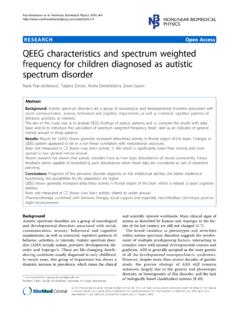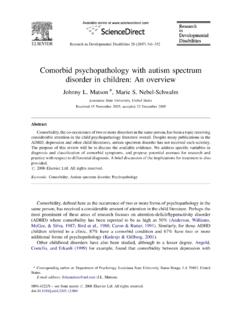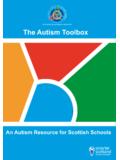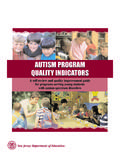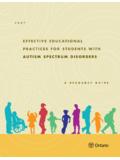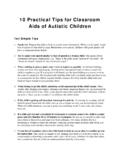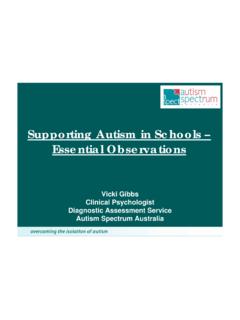Transcription of iMap Centre fact sheet 1 What is an Autism spectrum condition
1 What is an Autismspectrum condition ?AUTISMiMap Centre fact sheet 1 What is an Autismspectr Some general features ofAutistic spectrum ConditionsPlease remember each person is an individual with individual ability of an individual can often mask theirdisability yet we sometimes focus on thedisability and ignore the potential of the of the first and most widely accepteddefinition of ASC was formulated by Wing andGould (1978); they identified a Triad ofImpairments in people with ASC: Impairment of social relationships Impairment of social communication Impairment of imaginationAutism arises as a consequence of the interaction of these three impairments;therefore all three must be evident to diagnoseAutism.
2 The degree to which an individual is affected by each of the three impairmentscan vary the triad of impairments may presentthemselves and affect an individual:Impairment of social relationships Aloof from over-formal or stilted in socialcontact, to isolative behaviour, includingbecoming electively mute and completewithdrawal from interpersonal extreme circumstances the individual mayneglect all aspects of personal care and hygiene. Active but odd own needs seen as priority,little ability or desire to live in communalsituations with others. Little or no concept ofconsensus or compromise. Little or nounderstanding of social rules and societalnorms. These difficulties are compounded bydeficits in interpreting non-verbal behaviours,abstract concepts and complex language.
3 Passive accepts social approaches withindifference, will often comply with allrequests, therefore making them vulnerableto exploitation. May show some pleasure insocial contact, but make no spontaneousapproaches. Has difficulties dealing withstress and changes in of social communicationThe range of skills varies: People with no form of expressivecommunication and poor understanding People with what appears to be perfectlygrammatical speech Absence of any desire to communicate Echolalic and repetitive speech Expression of needs only Makes factual comments, often irrelevant tothe social situation Talks incessantly regardless of response by others Displays distortions of the rules of language Literal interpretation Referring to self in third person Little understanding of body language orfacial expressionsImpairment of imagination Difficulty in understanding that other peoplesee things from a different point of view Inflexibility in the application of both written and unwritten rules that govern social behaviour Repetitive enacting of roles withoutunderstanding purpose Difficulties in generalising concepts Literal understanding of language Difficulties in distinguishing between pretend and reality Lack of empathy for others Impairment of creative
4 Imaginative conceptsAUTISM Specific cognitive difficulties, including: Theory of mind deficits: inability toattribute thoughts and beliefs of others Executive function: difficulty withsequencing, organising Central coherence, understandingcause and effectAreas of difficulty often present in autisticspectrum conditions Repetitive and ritualistic activities Inflexible routines Resistance to change Poor ability to manage anger and frustration Problems with sleeping, feeding and toileting Additional fears and phobias Problems in gender identity Inappropriate expression of sexual feelings Anti-social behaviour Interpersonal violence Severe anxiety Inflexibility in application of social rules,particularly where these apply to themselves Awareness of the social relationships normalto others and difficulty in achieving the same relationships Difficulty in coping with social demands and situationsGetting a diagnosis can have many positive outcomes A diagnosis of ASC makes it clear that odd behaviour is the result of a pervasivedevelopment disorder, not mental illness orpersonality disorder Parental guilt may be relieved, enablingthem to concentrate on seeking help, ratherthan wondering what went wrong Placements can be evaluated as to how they can meet the characteristic needs of the condition .
5 As uniquely expressed in each individual Communication can be augmented ortailored to most effectively overcomeindividual problems in information processing The individual can be given emotionalsupport and therapy appropriate to thecharacteristic needs of the condition andtheir idiosyncrasies Behavioural management and riskassessment can be designed to meet thecharacteristic problems and needs of the condition Making the connections between thebehaviours we observe and the cause ofthose behaviours, creates understanding Understanding the cause of the behaviourgives us the opportunity to predict, plan for,and promote the positive and prevent the negative It enables an individual to gain insight intotheir difficulties and find ways to managethem more effectively Expectations can be realistically structuredand practical plans made for the future Helpful ways to support people with ASC Remove distractions emphasise what is relevant Keep language clear.
6 Simple and delivered in a calm manner Use visual guides do not rely on theperson s memory Find the person s area of interest Avoid open-ended tasks or imaginativeactivities requiring abstract thought or concepts Build routines/rituals/special interests into learning Use short tasks with frequent breaks Re-teach skills in each new setting Keep rules/approach consistent Use positive instructions um condition ? iMap Centre fact sheet 1individualsMakingautismpositive- The iMap Approach iMap s person centred care planning approach takes careful consideration of the requirements ofeach service user s needs as identified within the social work assessment, and any other relevantassessment that identifies the care, support and therapeutic needs of a service user.
7 This enablesiMap to provide enhanced opportunities for children and adults to improve communication andrelationships, continually develop independence skills and assist people to lead fulfilling lives and achieve the best possible promotes an Intensive Interactive approach, so that all staff are trained and familiar with different techniques for working successfully with complex learners. We emphasisecommunication and empathy for service users and by drawing on SCERTS, PECS and IntensiveInteractions staff within all of our supported living and residential care environments are able toprovide structure, calmness and clarity to each service user to reduce their anxiety and promotetheir learning and development. iMap provides: Intensive Interaction focused support to service users A SCERTS informed approach to assist service users to build competence in SocialCommunication, Emotional Regulation and Transactional Support A total communication approach to speech and language therapy, including use of PECS,Makaton and social stories Music therapy Art therapy Multi-sensory experiences Behavioural support programme, informed by PROACT-SCIPr-UK behavioural support techniques In house medical support and health further enquiries please contact us on 01606 301 514 or visit our website at Centre Limited Forest Road Cuddington Cheshire UK CW8 2 EHtel:01606 301 514 fax:01606 301 516
